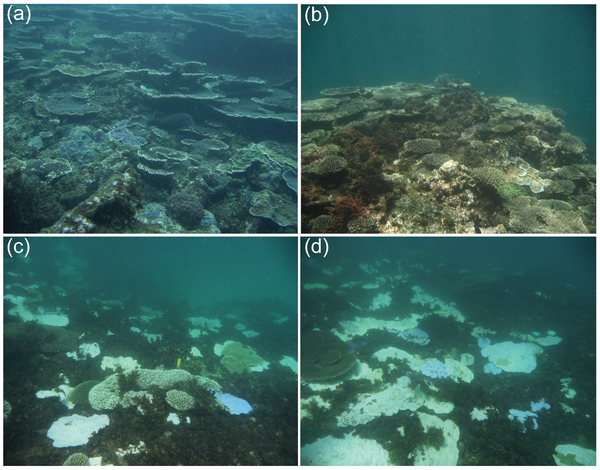
Images depicting the coral reefs of the Abrolhos prior to the 2011 bleaching event at site EG1 (a–b), and during the 2011 bleaching event at site EG2 (c–d).
Situated at almost 29 degrees south latitude, the Houtman Abrolhos Islands are home to a diverse set of coral containing approximately 184 different species. These reefs contain a mix of tropical and temperate coral, which are predominantly Acropora spp. A warmer than usual 2011 La Niña event subjected these coral to warmer than normal water temperatures and produced the first ever recorded bleaching event at this site. A bleaching episode at this high latitude was before unheard of as it was thought that these reefs were far enough away from the equator.
The results of this bleaching event are found in the PLoS ONE paper “Turning up the Heat: Increasing Temperature and Coral Bleaching at the High Latitude Coral Reefs of the Houtman Abrolhos Islands.” In their paper, researchers David Abdo, Lynda Bellchambers, and Scott Evans probed the event to better understand what happened.
They examined historical sea surface temperature data for the Houtman Abrolhos Islands area from 1900-2011 in addition to evaluating data from temperature dataloggers placed around the islands back in 2008. This, combined with annual coral surveys conducted since 2007, helped them calculate bleaching thresholds for different areas around the islands.
Their data indicated the 2011 sea surface temperature spiked to 29.5°C, which was 4.2°C above what was recorded for 2008-2010. This large temperature increase caused approximately 12% of the coral to bleach with 50% of the bleached coral dying following the event. Long-term data from the site also indicated that the sea surface temperature is rising at 0.01°C per year.
Given the above data, it raises the potential for future bleaching episodes in this area of the world and is another grim reminder of what can happen as our ocean temperatures continue to increase.









0 Comments